1/ A few thoughts about this defense of Columbus Day/attack on Indigenous People’s Day.
nypost.com/2019/10/12/col…
nypost.com/2019/10/12/col…
2/ The argument is familiar enough: European “civilization” (cast here as “democracy”) is superior to the “savagery” of Indigenous people.
3/ The argument depends on a strawman: “Columbus didn’t bring cruelty to peaceful, benign peoples. The indigenous people were also cruel to one another.” True there is some popular culture/new age romanticism, but scholars, including Native scholars, don’t think this.
4/ The argument also depends on sensationalism and cherry-picking (cannibalism, ritual sacrifice of women, scalping alive). Again, no one denies these things. But there are serious questions about context and typicality given 1000s of Native communities/polities in 1492.
5/ The argument also depends on uncritical repetition of myth of “America and the shining example of liberal democracy and human rights it became.”
6/ But what about: Drones killing Muslim civilians? Nuclear destruction of Hiroshima and Nagaski? Carpet bombing of North Vietnam? Multiple Trails of Tears and massacres to remove Indians from lands desired by white settlers and enslavers?
7/ Apparently the creation and maintenance of “liberal democracy and human rights” was not so benign, or am I just cherry-picking?
8/ There are many reasons to celebrate Indigenous People’s Day and not Columbus Day. Here are three:
1. Counters entrenched myths about American superiority.
1. Counters entrenched myths about American superiority.
9/
2. Recognizes the resilience and survival of Indigenous people in the face of genocide.
2. Recognizes the resilience and survival of Indigenous people in the face of genocide.
10/
3. At a time of an unprecedented world crisis (climate change), all of us need Indigenous knowledge.
#nativetwitter and #twitterhistorians can provide additional reasons, I'm sure.
/end
3. At a time of an unprecedented world crisis (climate change), all of us need Indigenous knowledge.
#nativetwitter and #twitterhistorians can provide additional reasons, I'm sure.
/end
• • •
Missing some Tweet in this thread? You can try to
force a refresh

















